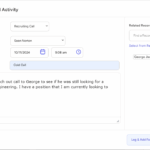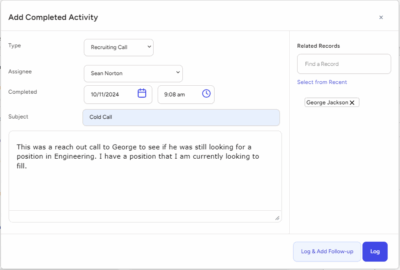Effective internal communication is essential to the success of any recruitment team. When your recruitment operation is small, with just a couple of employees, communication is often seamless and informal. But as your team expands, communication complexity grows exponentially. Poor communication can result in misunderstandings, reduced productivity, and costly mistakes—challenges no growing business can afford. To scale your recruitment team efficiently, you need to optimize communication methods, including structuring your team, holding intentional and productive meetings, developing best practices, and utilizing cutting-edge communication tools.
In this article from Top Echelon Recruiting Software, we will explore how to structure your recruiting team for efficient communication, the role of meetings, the importance of documented best practices, and how to leverage technology to streamline communication. This holistic approach ensures that as your team grows, communication will remain smooth, allowing for increased productivity and collaboration.
Building an Effective Recruiting Team Structure
The foundation of any efficient communication strategy begins with a clear and well-defined team structure. A strong structure establishes a chain of command, ensuring that each team member knows whom to report to and where to seek guidance. This clarity reduces confusion, speeds up decision-making, and prevents bottlenecks in workflow.
For most medium-sized recruitment agencies, there are generally four hierarchical levels:
1. Agency Director
The agency director is the top decision-maker, responsible for steering the company’s long-term strategy, financial health, and overarching goals. While the director isn’t involved in day-to-day operations, their leadership sets the tone for the company’s direction. Sales and recruiting managers report directly to the director, but junior employees typically don’t interact with them on a day-to-day basis. Effective communication from the agency director filters down through managers, ensuring all departments are aligned with the company’s mission and objectives.
2. Sales Manager
The sales manager oversees all business development activities, focusing on client acquisition and retention. This individual leads a team of sales and customer success representatives, who are responsible for nurturing relationships with clients and ensuring that their hiring needs are met. The sales manager reports to the agency director, ensuring that business development strategies align with company goals. Strong internal communication between the sales and recruitment departments is essential to meeting client expectations and delivering top talent.
3. Recruiting Manager
The recruiting manager is responsible for all candidate-facing activities. This manager supervises junior recruiters and sourcers, ensuring that the recruitment process runs smoothly and that the team works together efficiently. The recruiting manager reports to the agency director and serves as the link between high-level company objectives and the day-to-day tasks of recruiting. Communication within the recruitment team—between the recruiting manager, recruiters, and sourcers—must be clear and constant to avoid delays in candidate sourcing, interviews, and placements.
4. Recruiters, Sourcers, Sales, and Support Staff
These employees are at the operational level, focusing on sourcing candidates, managing client accounts, and supporting sales or recruiting efforts. While they don’t manage anyone, they play an integral role in driving the business forward. Recruiters and sourcers report to the recruiting manager, while sales and support staff report to the sales manager. Each employee must understand their role within the larger team structure to maintain effective communication and workflow.
As your recruitment team grows, it’s important to review and update your team structure to ensure it continues to facilitate efficient communication. Clear lines of authority prevent confusion, minimize redundancy, and ensure that each team member is held accountable for their work.
Effective Team Meetings: Enhancing Communication Through Structure
Meetings are often viewed as time-consuming and unproductive, but they are essential to maintaining alignment and fostering open communication within growing teams. The key to successful meetings lies in structure. Meetings should have a clear purpose, specific goals, and involve only the necessary participants.
One-on-One Meetings
One-on-one meetings provide a private space for employees to share updates, voice concerns, and receive feedback. These meetings, which should occur at least a few times a year, foster trust between employees and their managers, enabling open communication about performance, development, and well-being. For recruiters, these sessions are a chance to discuss their progress in candidate sourcing and client relationships. Structured one-on-ones can lead to better job satisfaction and a clearer understanding of expectations, which ultimately boosts productivity.
Departmental Meetings
Departmental meetings should be regular, quick check-ins that keep teams aligned. For example, a daily 10-minute meeting can be used to discuss what was accomplished the previous day and what the focus is for today. These meetings foster transparency and help team members stay on track with their goals. Recruitment teams, in particular, benefit from these quick syncs, as they ensure that candidate pipelines are progressing smoothly and that no communication gaps exist in client interactions.
Company-Wide Meetings
Company-wide meetings are important for keeping all departments in sync with overall business objectives. At companies like CATS, these meetings take place once a week for about 30 minutes, during which different departments share updates and provide feedback. These gatherings help to maintain transparency between departments, allowing teams to understand the broader company goals and how their work contributes to the company’s success. This is also an opportunity for employees to provide input on company culture and operations, promoting a sense of community and shared purpose.
Best Practices for Structured Meetings
To ensure meetings are effective, follow these best practices:
- Plan ahead: Have a clear agenda with goals and topics to be discussed.
- Time management: Stick to the scheduled time. If it’s meant to be a 15-minute meeting, do not let it drag on. Conclude with a clear decision or follow-up action.
- Assign roles: Designate someone to lead the meeting, keep time, and take notes. This ensures that everyone stays focused and that important decisions are documented for future reference.
Developing and Documenting Best Practices
As your recruitment team grows, it becomes increasingly important to formalize your company’s processes and best practices. By creating a documented system of processes, you establish a consistent way of doing things that can be shared with all employees. This not only enhances communication but also streamlines onboarding for new hires and ensures everyone is on the same page.
1. Creating a Standard Operating Procedure (SOP)
A Standard Operating Procedure (SOP) is a document that outlines the correct processes for completing specific tasks. For a recruitment team, SOPs could include how to source candidates, manage client relationships, or use your applicant tracking system (ATS). SOPs provide a “one source of truth,” which helps reduce miscommunication and sets clear expectations for all team members.
2. Regularly Reviewing and Updating Best Practices
What worked for a small team might not be effective for a larger group. It’s essential to regularly review your best practices to ensure they still make sense for your company’s current size and structure. Encourage team members to provide feedback on existing practices and be open to evolving your processes to meet new challenges.
Leveraging Your Applicant Tracking System (ATS) for Better Communication
One of the most powerful tools at your disposal for improving internal communication is your applicant tracking system (ATS). A robust ATS does more than track candidates—it also serves as a central hub for collaboration, allowing team members to share notes, track progress, and ensure consistency across all client and candidate interactions.
1. Notes and Activities
The ability to leave detailed notes on candidate and client records is crucial for collaboration. Your ATS should allow team members to document their work in real-time, making it easy for others to pick up where they left off. For example, if a recruiter leaves a note that they called a candidate and left a voicemail, another recruiter can review that information and avoid duplicating efforts. Standardizing how and when notes are entered into the system ensures consistency and clarity.
2. Email Sync
Email synchronization automatically pulls in email exchanges between recruiters and clients or candidates, attaching these messages to the relevant records. This ensures that all communication is transparent and visible to the entire team. Email sync prevents miscommunication, reduces redundant outreach, and allows team members to follow up appropriately.
3. Status Tracking
Tracking a candidate’s status throughout the recruitment process is vital for understanding how far they’ve progressed in your pipeline. Status tracking not only provides visibility into individual records but also offers valuable insights into your recruitment process as a whole. By reviewing candidate statuses, managers can identify bottlenecks and make adjustments to improve efficiency.
4. Reports and Analytics
Your ATS should be capable of generating reports that provide a high-level overview of key metrics such as placement rates, candidate pipelines, and recruiter activity. These insights enable your team to make data-driven decisions, optimize performance, and address communication gaps. By understanding and acting on this data, you can improve your internal communication and overall recruitment process.
Essential Communication Tools for Recruitment Teams
In addition to using an ATS, there are several other communication tools that can enhance team collaboration and productivity. Familiarizing your team with these tools will help streamline communication, reduce redundancy, and improve workflow.
1. Slack
Slack is one of the most popular communication platforms for teams, offering real-time messaging, file sharing, and integrations with many other software tools. It allows teams to create channels for specific projects, departments, or topics, ensuring that conversations stay organized. Slack’s ease of use and integrations with recruitment software make it a perfect fit for recruitment teams.
2. Google Workspace (Docs, Sheets, Drive)
Google Workspace is a cloud-based platform that allows for real-time collaboration on documents, spreadsheets, and presentations. Google Docs and Sheets enable team members to work on projects simultaneously, leave comments, and track changes. These tools are essential for recruiters who need to collaborate on client presentations, candidate profiles, or internal reports.
3. Igloo
Igloo is an intranet solution that acts as a company-wide knowledge hub. It can be customized to display industry news, task assignments, and more. It’s particularly useful for recruitment companies that want to create a central resource for onboarding materials, process documentation, and internal news updates.
Scaling Communication for Long-Term Success
As your recruitment team grows, maintaining effective internal communication becomes increasingly challenging but equally essential. By structuring your team with clear reporting lines, holding efficient meetings, documenting best practices, and leveraging tools like your ATS and modern communication platforms, you can scale your team without sacrificing productivity or collaboration. The key to success lies in adapting your communication strategies as your team evolves, ensuring that every team member stays aligned with your company’s goals and processes. With a solid foundation of communication, your recruitment team will be well-equipped to thrive, no matter how large it grows.








